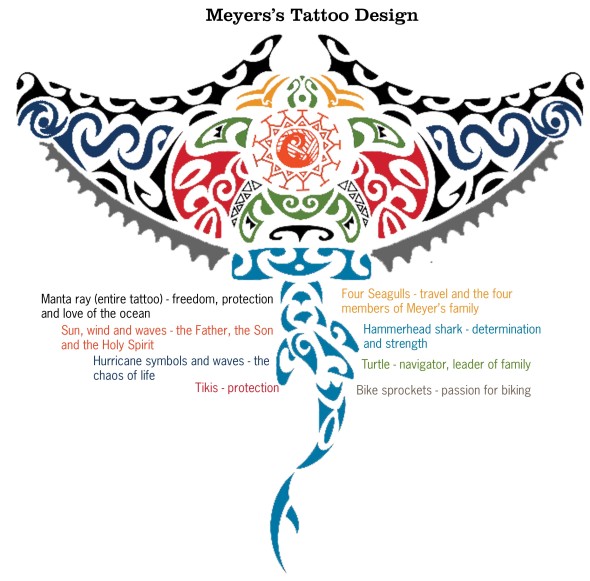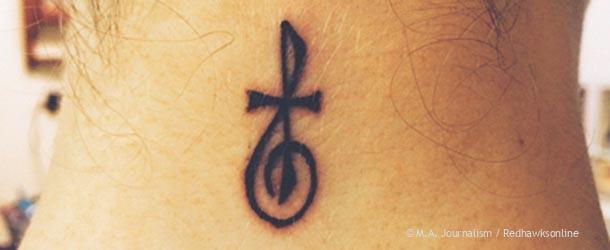Tattoos: a form of self expression or the road to regret?
“The turtle stands for navigator, you’re a leader in the family,” said science teacher Sam Meyers explaining the symbolism behind his tribal, Maori-style tattoo of a manta ray. “Inside the turtle is the image of a sun, wind, and waves. [There are also] hurricane symbols, so the hurricane is sending waves toward the turtle and I view it as the chaos of life because the world is not a pleasant place. It’s a very destructive world. The tikis stand for protection and I view it as the kind of father I want to be. I also view the turtle, sun, and wind as a double meaning for the Father, the Son and the Holy Spirit and how God has protected me and brought me through the dark times in my life.”
Meyers continued to point out the symbols in his intricately designed tattoo.

The design of Meyers’s tattoo is color-coded to highlight the symbolism. The actual tattoo is all black. Design courtesy of Sam Meyers, Graphic by Maddie Binning.
“There also are four seagulls here and the birds represent travel,” said Meyers. “My wife and I love to travel so the four of those represent the four of us because we have two kids. I [changed part] to make it look like a bike sprocket because biking is one of my passions as well. All of this is being pushed forward by the hammerhead shark which is a sign of determination and strength.”
In the past few decades, tattoos have gone from a symbol of rebellion to a widely accepted form of self-expression. According to a study of 500 people conducted in 2004, the American Association of Dermatology (AAD) reported that about one-fourth of people reported having a tattoo. However, opinions on the permanent art remain varied.
“I wanted [my tattoo] to be physical, spiritual, emotional, mental,” said Meyers. “My advice [to someone who wants a tattoo] would definitely be put a lot of thought behind it in those four areas. The physical area: think about where on your body you want it, considering future changes your body may undergo as you age. Is it going to be in a place where it’s just going to be distorted?”
Plans for the future
The potential to affect on the future even applies to the military. On Mar. 30 of this year, the military updated their regulations on tattoos, restricting tattoos larger than the open hand of the soldier on visible body parts and limiting the placement allowed. Existing tattoos as well as tattoos acquired by April 30 are allowed as long as they meet the level required level of appropriateness and “do not violate prohibitions on things like obscenity, racism or extremism.”
Regulations along these lines are common among businesses as well because while tattoos are considered a form of free speech, private employers are free to have their own tattoo policies. Bob Boisvert, an employment law expert at Minneapolis law firm Fredrikson & Byron, told the Star Tribune that employers must have a “legitimate, non-discriminatory business purpose” to restrict or ban tattoos, but many employers have them nonetheless. With this in mind, senior Bekka Welsh still believes that the decision to get tattoos should be made regardless of the opinions of others.
A personal decision
“If you have thought it through and it’s something you’re comfortable doing,” said Welsh, “you shouldn’t care what other people think about it and other people shouldn’t care about you having it. You can always get it recovered or there are ways to laser them off, but you should really think through what you want to get.”
The importance of thinking it through shows as the costs of cover-up tattoos or laser treatments are considered. According to the AAD, laser treatments can also require upwards of 10 sessions. For these reasons and others, Meyers waited 20 years to get his tattoo. This waiting period is an important factor to french teacher Mark Norlander as he suggests looking into the past to avoid regret in the future.
Thinking it through
“Go up to the library and look at a yearbook from 20 years ago and the way the kids all dress and their hairstyles,” said Norlander. “They thought at that time that was the coolest thing ever but now they go back and they look and think, ‘I can’t believe I did that [and] that was popular back then.’ I’ve known a lot of kids over the years that have gotten tattoos, and usually they come back and say ‘that was the dumbest thing I ever did.'”
These changes in perception can be tied to the series of life developments that psychologist Erik Erikson made famous. In the mid-20th century, Erikson outlined eight psychosocial stages in development which correspond with age. The eight stages, ranging from infancy to late adulthood, each have a unique “crisis” with the focus of adolescent years being primarily identity. According to Erikson, the crisis of identity throughout the adolescent years involves the exploration of earlier conflicts with ideas such as trust and independence. With that exploration comes new viewpoints and changing beliefs throughout the years, and many people feel as though tattoos make permanent the values which are altered by age.
Something to last forever
Tattoo artist and parent of a freshman by the same name, Titus McKnight urges people considering tattoos to think long-term.
“My advice would be stay off the internet,” he said. “The internet is great, but there are a lot of trends people jump on and regret later. [It’s best to get] something you truly feel for and have a passion for. Get something that’s going to last forever.”
McKnight suggests tattoos that relate to family members such as his own tattoos of his children, though he supports any tattoo that will have a lasting impact. Senior Emma Johnson recently got a tattoo that encompasses what she feels passionate about and that she feels will have lasting impact.
“Getting a tattoo was a decision that I [made] to show somewhere to people my core values because mine is a treble clef and a cross combined,” said Johnson. “I would say that getting it at this early of an age will encourage me to stay strong in my faith and my love for music. There’s really nothing major that could change the way I feel about them. I think that the permanence is a way to keep my faith and love for music strong.”
Meyers also sees his tattoo as encouragement to continue on in what he loves.
“I wanted it to be representative of who I am, what I’ve come from, and what I’ve been through,” said Meyers. “I want it to be an ongoing reminder of who I want to be as a person. I wanted something where I can always look at it and say ‘alright this is who I want to be, this is the kind of father I want to be, this is the kind of person of faith I want to be.’ I want to be someone who’s always chasing after my passions as well and not letting go of dreams. All of those things tied up in one.”

